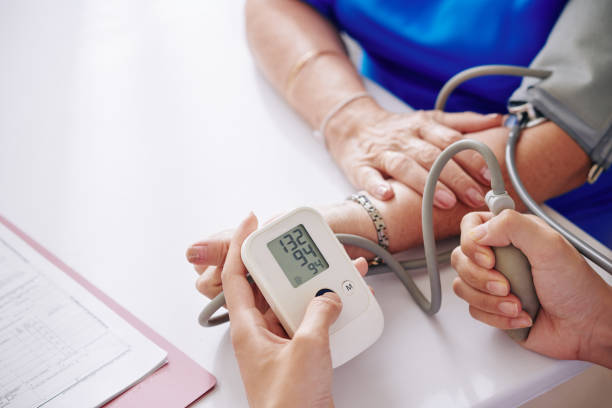Nursing care plan for COPD ( Chronic Obstructive Pulmonary Disease)
Use this guide to help you formulate nursing interventions for Chronic Obstructive Pulmonary Disease (COPD) nursing care plan for copd and nursing diagnosis.
COPD, also known as chronic obstructive pulmonary disease, is characterized by a severe blockage of the airway brought on by lung inflammation.
90% of COPD cases are related to cigarette smoking. Additional factors include a hereditary condition called alpha-1 antitrypsin (AAT) deficiency, hand-to-hand tobacco, and air toxicity.
dust and gas during work
Read Also: Nursing Care Plan For Hypertension
While airway clearance and gas exchange are the most typical problems among COPD patients, other symptoms can also be evaluated in COPD patients.
Emphysema and chronic bronchitis are two prevalent kinds of COPD, while refractory asthma, which is present in patients with a history of asthma, is a less common type.
However, all of these varieties exhibit similar symptoms, including a productive cough, rapid breathing, shallow breathing, shortness of breath, a feeling of congestion, and heaviness in the chest.

Types of Chronic Obstructive Pulmonary Disease (COPD)
The following are the types of chronic obstructive pulmonary disease.
Chronic bronchitis
The most common symptoms of chronic bronchitis, a kind of chronic obstructive pulmonary disease that affects the upper airways, are coughing and sputum production.
When a patient has had chronic bronchitis for at least three months over two years, the condition is considered to be chronic.
The majority of people with chronic bronchitis experience cyanosis; as a result, they are referred to as blue bloaters.
Emphysema
Emphysema is the name given to the condition where the walls of the alveoli are destroyed as a result of excessive air space distention beneath the terminal bronchioles.
As a result, the condition is also thought to be damaging the patient’s lower airways. The patient experiences difficulties with the gas exchange as a result of the damage, and the majority of the lobular gaps increase.
Read Also: Nursing Care Plan For FEVER
Signs and symptoms of Chronic Obstructive Pulmonary Disease (COPD)
Common signs and symptoms of COPD include: coughing out the mucus that lasts for a long time, challenges in taking a deep breath, breathlessness after a light workout (like walking or using the stairs), and breathing difficulty while completing daily tasks.
Wheezing.

Diagnosis of COPD
Your healthcare practitioner will gather information about your medical history, conduct a physical examination, and order some tests, including breathing tests, to evaluate the condition of your lungs and overall health.
Management of COPD
COPD has no known cure. To reduce symptoms and prevent the sickness from getting worse, however, there are a lot of things you may do.
It’s time to stop smoking if you do. This is the best method for reducing lung damage.
Other treatments include the use of medications like bronchodilators, inhaled steroids, combination inhalers, and antibiotics.
Lung therapies, for example, oxygen therapy, breathing devices, Management of exacerbations, and surgery can also serve as a treatment plan.
Nursing care plan for COPD Chronic Obstructive Pulmonary Disease
The most typical nursing diagnosis for patients with COPD are listed below:
- Ineffective airway clearance
- Impaired gas exchange
- Activity intolerance
- Ineffective breathing patterns
- Deficient self-care
- Risk for infection
- Nutritional imbalance: less than body requirements
Chronic Obstructive Pulmonary Disease (COPD) nursing care plan 1:
Nursing diagnosis:
- Ineffective Airway Clearance
- Related to :
- Hyperventilation or hyperventilation
- Inadequate lungs expansion
- Fatigue
- Secretions
- Anxiety
- Evidenced by
- Orthopnea
- Accessory muscles in breathing
- Increased respiratory rate
- Uneven respiratory rhythm
- Dyspnea
- Sputum production
Desire outcome
- The patient will sustain an effective respiratory pattern as evidenced by an even, unlabored respiratory rate and rhythm
- The patient will show techniques on how to improve breathing pattern
- The patient will verbalize factors contributing to an ineffective breathing pattern
Chronic Obstructive Pulmonary Disease (COPD) Assessment
- Access breath sounds and vital signs.
Monitor blood pressure, heart rate, and Sp02.
Check the lungs for atypical sounds like rhonchi, which may indicate residual secretions, by auscultating them.
- Take note of the breathing pattern
The breathing pattern should be watched for rate, depth, and irregularity.
Keep an eye out for nasal flare-ups, loud wheezing, and auxiliary muscle use.
- Monitor arterial blood gas (ABGs) and oxygen saturation.
Hypoxia is indicated by a decreasing sp02. The amount of carbon dioxide and oxygen in the blood is measured by arterial blood gases.
Check This: Nursing care plan for pneumonia
If abnormal, the lungs are not oxygenating the tissues properly, resulting in inadequate perfusion.
Chronic Obstructive Pulmonary Disease (COPD) Interventions
- Manage anxiety
Anxiety can lead to or be the result of an inefficient breathing pattern.
To lessen the patient’s fear—breathlessness is frightening—maintain a reassuring presence and remain by their side.
Make a calm setting with fewer distractions.
- Administer prescribed medication
Inhalable steroids and bronchodilators relax the airways and decrease inflammation to prevent exacerbations.
Steroids used orally or intravenously may also be given to decrease inflammation.
- Administer oxygen
Administer supplementary oxygen at the lowest possible concentration.
COPD patients are at risk of over-oxygenation if their respiratory effort is ineffective, resulting in harmful levels of O2 and CO2 (hypercapnia).
- Encourage pursed-lip breathing.
To begin, instruct the patient to relax and drop their shoulders so that they are not tense.
Pursed-lip breathing aids in slowing the respiratory rate and remaining relaxed. Instruct the patient to breathe in through their nose, pucker their lips as if blowing out a candle, and exhale.
Exhaling should take twice as long as inhaling.
Chronic Obstructive Pulmonary Disease (COPD) nursing care plan 2.
Participating in physical activities may become more difficult as COPD progresses.
Patients frequently have activity intolerance as a result of dyspnea, which has a severe impact on their strength and quality of life.
Nursing diagnosis:
Activity intolerance
Related to :
- Oxygen supply and demand of tissue
- Weakened diaphragm
- Sedentary lifestyle
- Deconditioning
- Evidenced by
- Fatigue
- Dyspnea
- Weaknesses
- Shortness of breath
- An abnormal rise in no in response to activity
Desire outcome
- The patient will participate in exercise while maintaining respiratory patterns and vital signs within normal range.
- The patient will report an increase in tolerance to performing tasks and exercise.
- The patient will verbalize techniques that aid in improving activity tolerance.
Chronic Obstructive Pulmonary Disease (COPD) Assessment
- Assess current activity level
Examine the activities in which the patient is now involved.
Examine the patient’s capacity to execute ADLs, ambulation, and level of debility.
- Examine the emotional factors that influence activity.
Depression caused by a loss of independence or anxiety caused by dyspnea can hinder a patient from engaging in physical activity.
If a patient appears uninterested or unwilling to cooperate, look for deeper issues.
- Assess the cardiopulmonary reaction.
Monitor vital signs, changes in the respiratory pattern, weariness, and an increased need for supplementary oxygen to ensure the patient is safe to exercise.
Chronic Obstructive Pulmonary Disease (COPD) Interventions
- Educate patients conservative technique
Teach patient on how to gradually increase activity level. And When feeling the most energized, the patient should do the chores that demand the most effort.
Show patients how to take frequent stops for rest. Reduce his or her speed. Brush his or her teeth or fold his or her laundry while sitting.
- Maintain a physical activity log.
Accelerometers, which can track physical activity, are now widely available.
They are worn around the arm or waist and monitor posture, energy consumption, and the number and intensity of bodily movements.
Simple pedometers can also be effective for tracking physical activity over time.
- Teach diaphragmatic breathing.
Diaphragmatic breathing can be beneficial to employ during daily tasks such as stair climbing, showering, and going on lengthy walks.
It takes practice, but it will strengthen your diaphragm. When you inhale, your abdomen should rise, and when you exhale, it should fall.
Placing your hands on your chest and abdomen will reveal whether or not this is happening.
- Educate patient about medication
Long-acting bronchodilators, such as Spiriva, have been found to improve exercise endurance by increasing patient engagement in physical activities, which improves quality of life.
Chronic Obstructive Pulmonary Disease (COPD) nursing care plan 3:
Nursing diagnosis:
Deficient Knowledge
Related to :
- Misinterpretation of education
- Lack of interest
- Lack of knowledge about disease
- Lack of understanding
Evidenced by
- Request for additional information or clarification
- Verbalizes inaccurate information
- Demonstrates incorrect techniques
- Poor follow-through with tests or treatment
- Development of worsening condition
Chronic Obstructive Pulmonary Disease (COPD) Assessment
- Access how well the patient learns best.
Medical information might be difficult to understand. Provide information that is simple to understand and free of jargon. Make use of repetition.
Give verbal and written instruction, as well as photos or videos, to reinforce breathing practices or how to use inhalers or oxygen effectively.
- Access patient’s readiness and motivation
Access the patient’s eagerness to learn about their ailment.
It will be pointless to instruct if the patient is not intellectually or emotionally prepared.
Investigate their motivation to study, or lack thereof.
- Educate patient on medication to improve tolerance.
Long-acting bronchodilators, such as Spiriva, have been found to improve exercise endurance by increasing patient engagement in physical activities, which improves quality of life.
- Access for support system
Chronic illnesses can be tough to handle on your own.
Look for family members or friends who can help the patient reinforce educational instructions.
Chronic Obstructive Pulmonary Disease (COPD) Interventions
- Instruct on how to avoid and recognize exacerbations.
Exacerbations of COPD are defined as a worsening of symptoms that lasts for days or weeks and frequently necessitates hospitalization.
A flare-up might be brought on by respiratory infections, pollutants, or allergies. If the patient notices an increase in coughing, dyspnea, changes in sputum, or problems sleeping, they should call their provider.
- Health educate on hygiene practices.
Staying healthy strengthens the immune system, allowing it to fight off diseases and viruses.
- Recommend pulmonary rehabilitation.
Pulmonary rehabilitation teaches fitness training, nutrition recommendations, and COPD-specific counseling.
- Stop smoking.
This is one of the most critical instructions that may be given if the patient smokes. Quitting smoking is challenging, but it is necessary for maintaining lung function and avoiding exacerbations.






